Florence is known as the “Cradle of the Renaissance.” With the best Medieval and Renaissance art in Europe, Florence is a veritable art lovers paradise.
There are so many amazing cultural attractions and things to do in Florence. You’re spoiled for choice in the city of the Italian masters.
It would take weeks to see everything Florence has to offer. Any one of its dozens of churches, palaces, and museums would be the prize tourist attraction in a smaller city.
You can be seduced by Botticelli and awed by Michelangelo, in a time tunnel experience. Not surprisingly, Florence’s entire city center is a designated UNESCO site.
In this guide, you’ll visit frescoed churches, majestic cathedrals, elegant palaces and piazzas, and world class museums. And walk the same flagstones as Leonardo, Dante, and Galileo.
>>> Click here to book a guided walking tour of Florence
Top Must Visit Attractions in Florence
If you’re planning on a lot of sightseeing, you can choose between the Florence Pass, the Donatello Bundle, or the Super Combi Pass.
The Florence Pass is the most comprehensive. You have skip the line access to the entire Duomo complex (including the dome climb), the Uffizi, and the Accademia.
1. Uffizi Gallery
Florence is synonymous with the Renaissance period of art history. The Uffizi Gallery is its premiere museum, and the third most visited site in all of Italy. For art lovers, the Uffizi is a place of pilgrimage.
The Uffizi houses the collection of the Medici, a wealthy family of art patrons that ruled Florence for three centuries. The museum has seminal works from the 13th to 18th centuries.
Some of the world’s most famous paintings are in the Uffizi — Botticelli’s Birth of Venus and Primavera, Titian’s Venus of Urbino, Leonardo da Vinci’s Annunciation, Caravaggio’s Medusa and Bacchus, and Raphael’s Goldfinch Madonna.
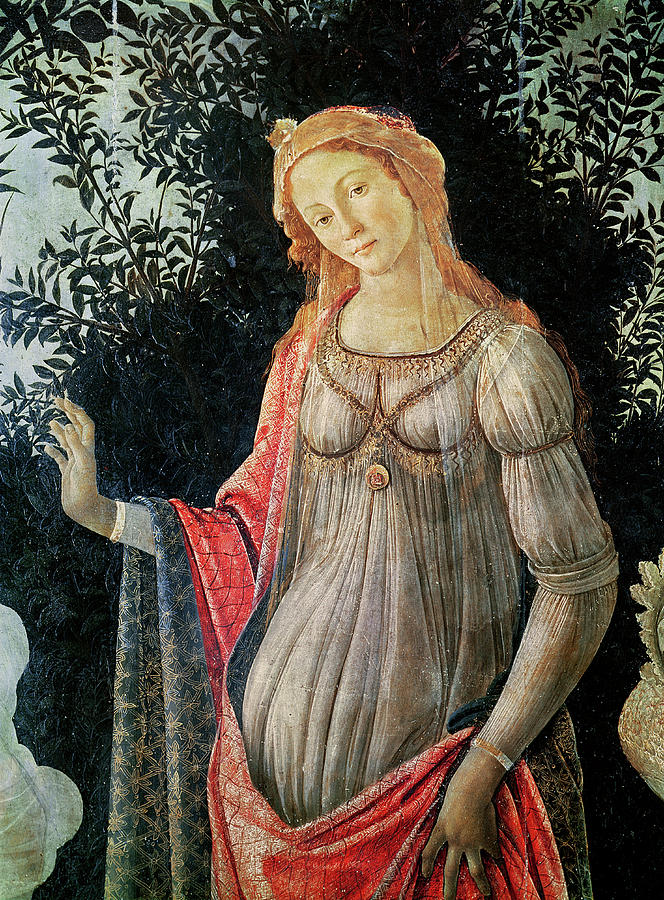
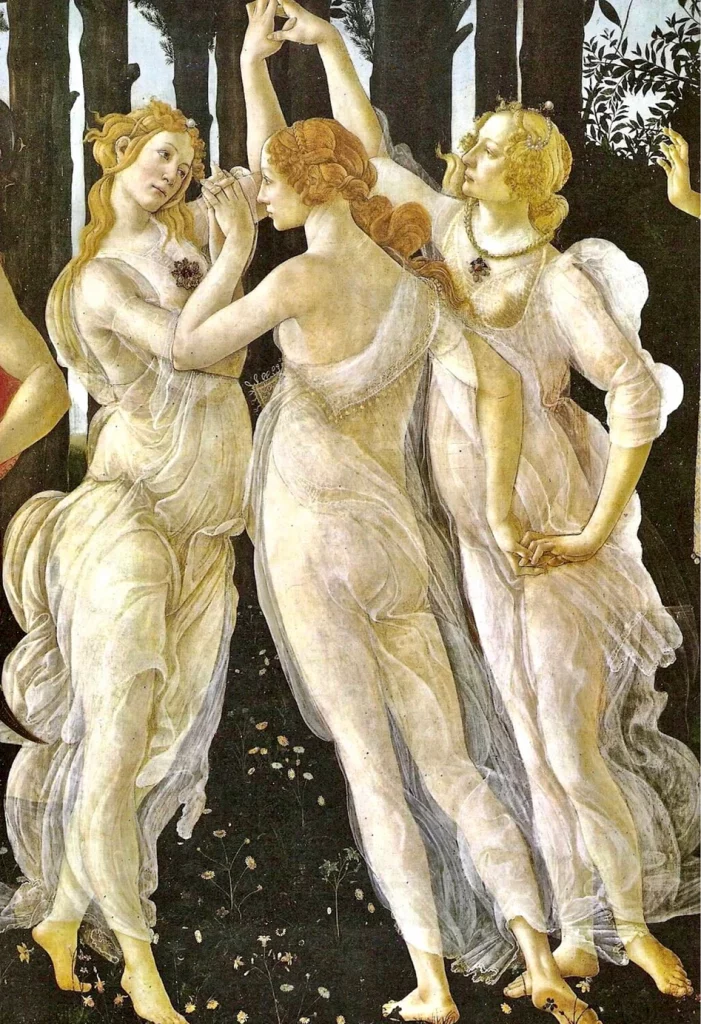
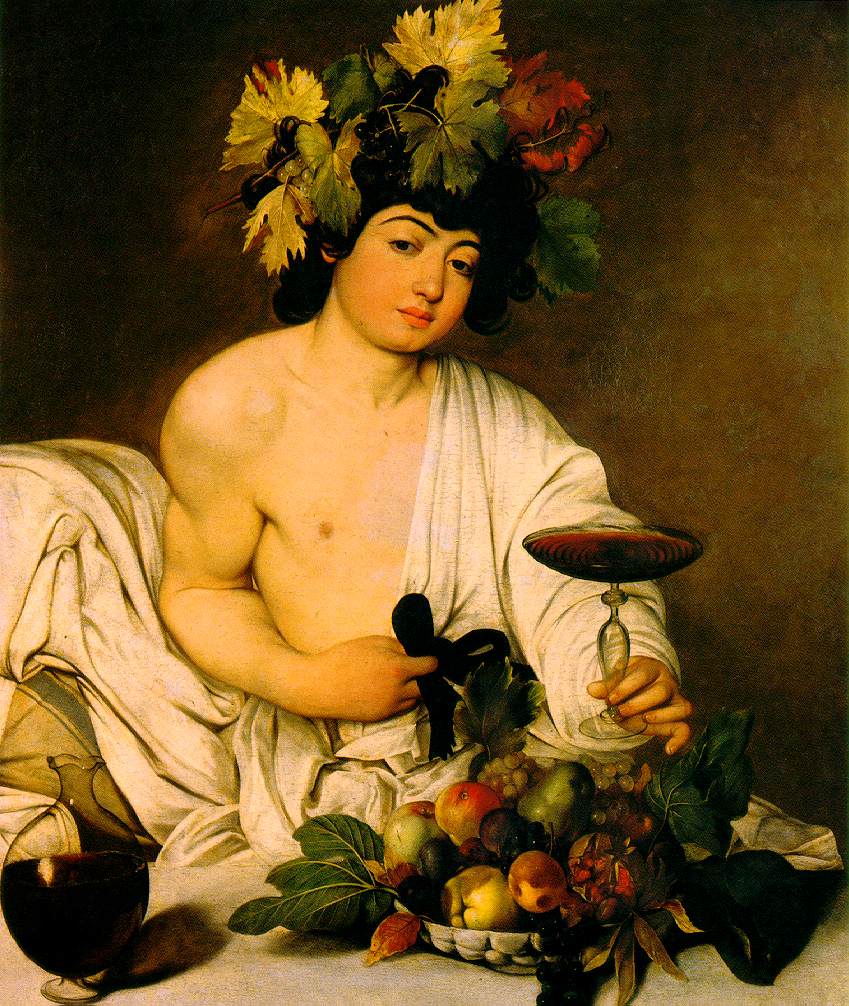
The Uffizi consists of 45 halls of art spread over two floors of the palace. If you have limited time, you should focus your efforts.
The must see halls include the Hall 2 (Giotto), Hall 8 (Lippi), Hall 10-14 (Botticelli), Hall 15 (Leonardo), Hall 35 (Michelangelo), Hall 66 (Raphael), Hall 83 (Titian), and Hall 90 (Caravaggio).
Here’s my complete guide to the Uffizi Gallery, which includes must see masterpieces and tips and tricks for visiting.
It’s essential to pre-book a timed entry skip the line ticket well in advance. Otherwise you will likely stand in line for hours.
2. Galleria dell’Accademia
After the Uffizi, the Accademia Gallery is Florence’s most visited museum. People line up to see what is probably the world’s most famous sculpture, Michelangelo’s commanding statue of David.
The 17-foot sculpture of David is often celebrated as a pinnacle of male beauty, resembling a classical Greek athlete in its representation of idealized physical perfection.
Initially commissioned for the Florence Cathedral, the statue’s remarkable beauty led to a change of heart.
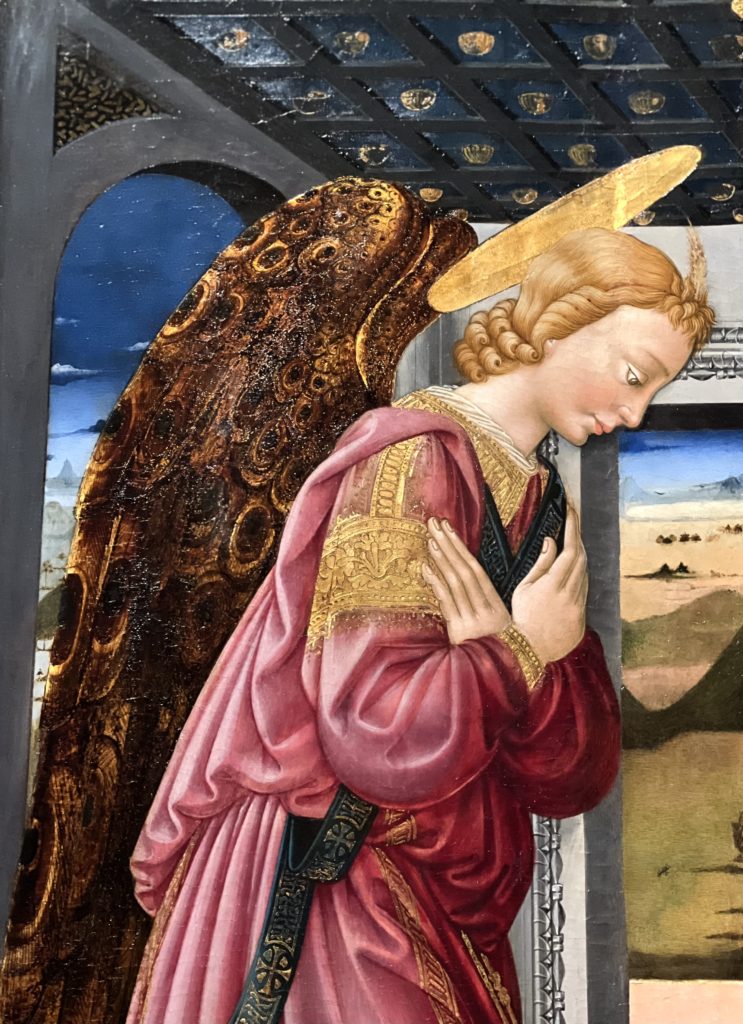
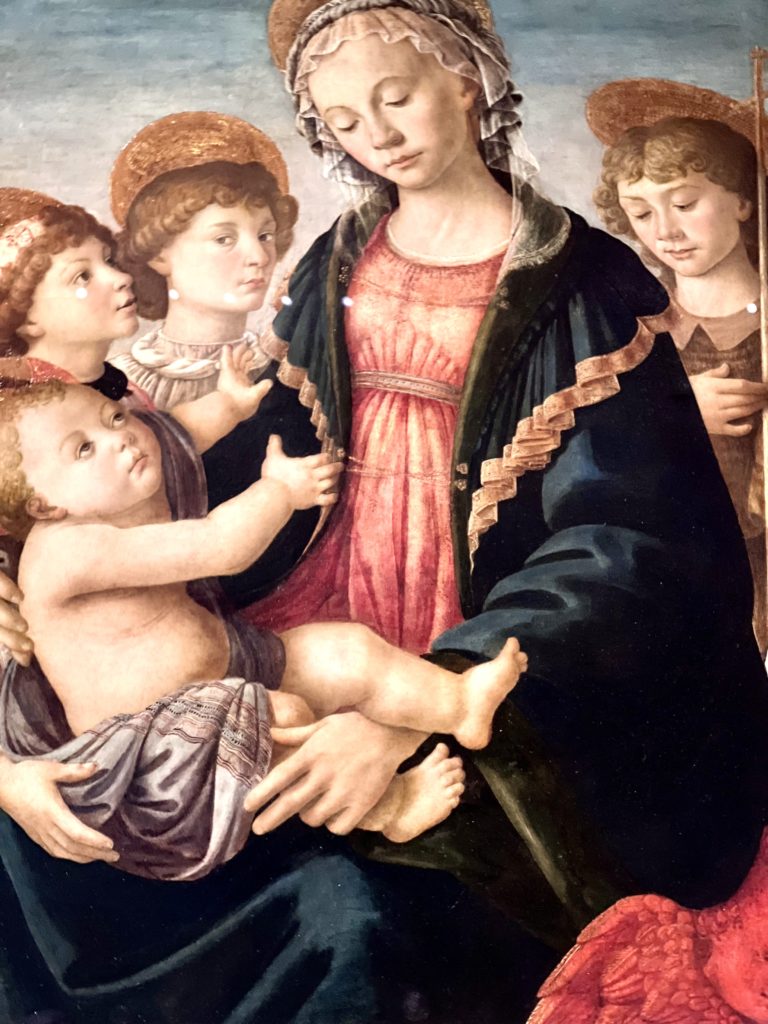
Rather than its original destination, it was placed in a position of honor outside the Palazzo Vecchio, deemed too magnificent for a more modest setting.
In 1873, to preserve its artistic integrity and protect it from weathering, David was moved to the Accademia Gallery
Michelangelo’s Prisoners grace the Hall of the Prisoners at the Accademia. They are four unfinished male nudes that were originally intended for the Tomb of Pope Julius II. You can see Michelangelo’s approach to carving; the figures appear to be emerging from the marble.
>>>Click here to book a timed entry skip the line ticket
3. National Museum of the Bargello
The Bargello houses an amazing collection of Renaissance sculptures.
The most important works are in the Michelangelo and Donatello rooms. Those include Michelangelo’s first major sculpture, Bacchus, and his Pitti Tondo, Donatello’s acclaimed Bronze David and St. George, and Bernini’s Bust of Costanza.
Commissioned by Cosimo de Medici, Donatello’s Bronze David is a daring depiction of a biblical theme. It’s the first freestanding nude sculpture since Greco-Roman times. But it’s not a heroic rendering.
A nubile David is peculiarly depicted wearing no clothes except for a hat and boots, perhaps to suggest his underdog status. The statue is affectionately nicknamed “Puss ‘N Boots.”
The Bargello also houses the Competition Panels. In 1401, Florence held a competition for a set of bronze doors to be made for the Baptistry of the Duomo. Ghiberti won the competition.
Click here to book a skip the line ticket. You may also want to book a 1 hour guided tour of the Bargello or a 1.5 hour private tour with an expert.
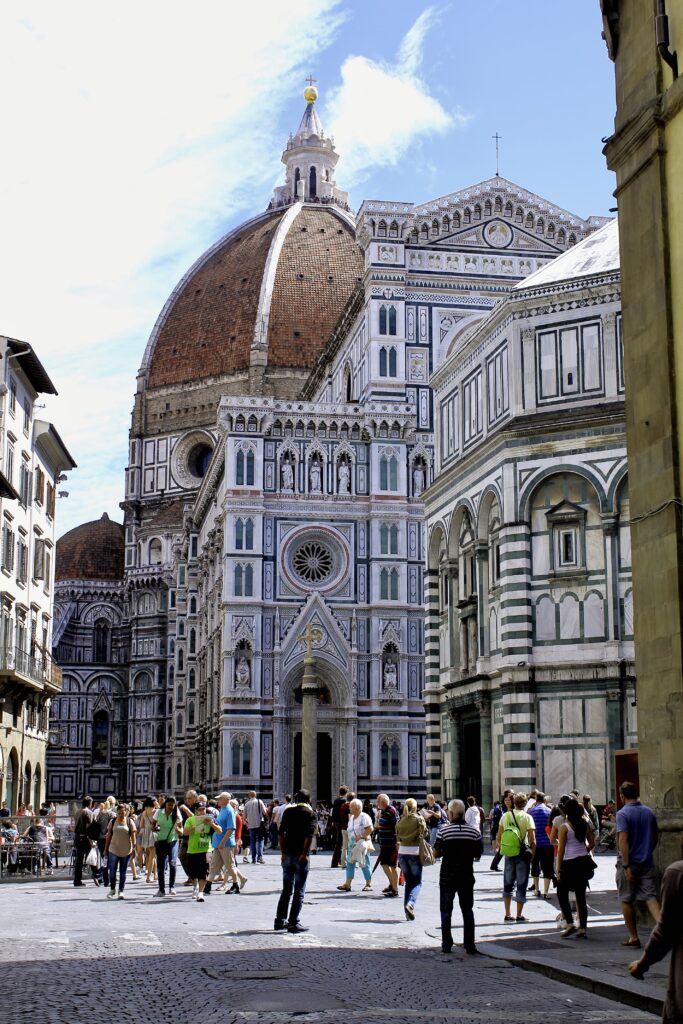
4. The Duomo, Florence Cathedral
Florence Cathedral is the most prominent landmark in Florence. It sits pretty in a pedestrianized piazza.
Florence Cathedral is Gothic in style, but not in the light and elegant way you think of Paris’ Notre Dame. It’s made of brown sandstone and beautifully faced with pink, green, and white marble.
For two centuries, the Duomo was the largest (longest) cathedral in the world. Today, it’s the third largest behind St. Peter’s Basilica in Rome and St. Paul’s Cathedral in London.
While Florence Cathedral is elegantly “frosted” with colored marble on the outside, inside Florence Cathedral is austere and almost empty. You might even wonder if it was ever finished.
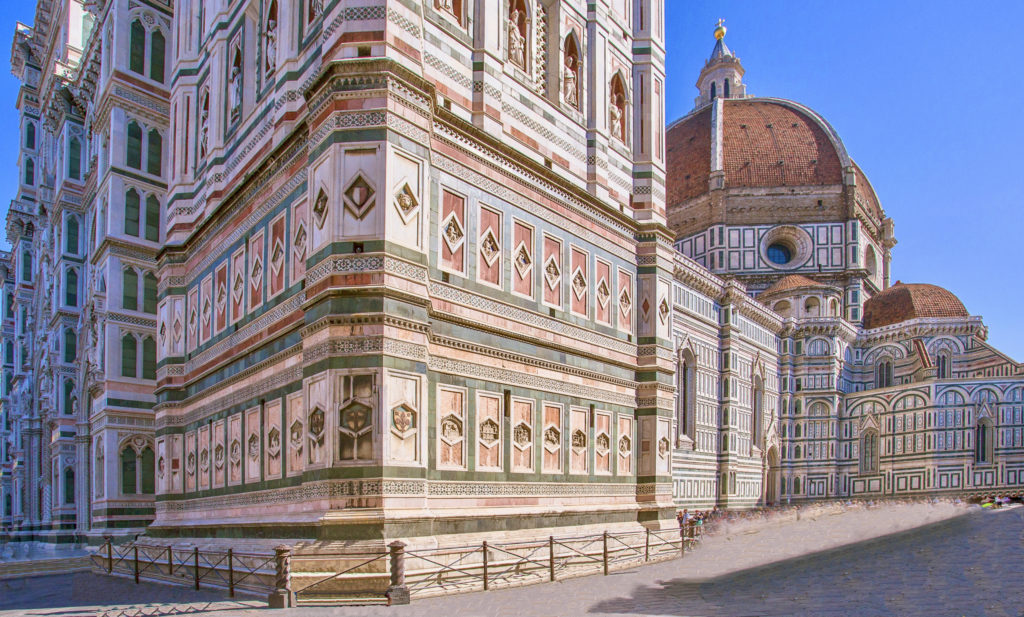
Filippo Brunelleschi’s magnificent terra cotta colored dome, begun in 1418, is the highlight. Brunelleschi was the perfect balance of architect and engineer.
It’s absolutely essential to pre-book a ticket to climb Brunelleschi’s dome. That’s the only way you can visit.
You can also book a combination guided tour for the Baptistery, Duomo Museum and a dome climb. This 3 hour combination guided tour covers the four attractions I’ve just mentioned, plus Giotto’s bell tower.
5. Duomo Museum
The Duomo has an absolute must visit museum, the Opera del Duomo Museum. It’s housed in the Piazza del Duomo at the back of Giotto’s Bell Tower. It also offers a nice view of the Brunelleschi’sdome from its terrace.
The first thing you see when you walk in the museum is the magnificent Hall of Paradise. The hall contains a magnificent reconstruction of a Duomo facade.
It was torn down in 1587 to make room for a Renaissance facade. But the intended facade was never completed. The reconstructed facade has exact replicas of the sculptures that once adorned it.
The other must see masterpieces in the Duomo Museum are Ghiberti’s Gates of Paradise, Michelangelo’s unfinished Florence Pieta, the Gallery of Giotto’s Bell Tower, and Donatello’s Penitent Magdalene.
One of Michelangelo’s last masterpieces, the Pieta is currently being restored behind glass walls.
Here’s my complete guide to the Duomo Museum. You can book a 2 hour guided tour that includes the Duomo Museum, the Duomo, and the Baptistery.
6. Giotto Bell Tower | Campanile
Giotto’s Bell Tower is adjacent to the Duomo, but still a separate building. When the construction of Florence Cathedral dragged on, the city decided to build something quickly for the citizens.
In 1334, the city hired a big gun, Giotto, the best artist of the 14th century. But at that time, artists rarely doubled as architects. It’s unclear how much design influence he really had.
Giotto died three years later. An architect named Francesco Talenti stepped in to finish the job. He was later named chief architect of Florence Cathedral.
If you have a passion for panoramic views, you should climb the 414 steps of the tower. The steps are narrow, which makes for a cramped but rewarding experience. But it’s one of the best viewpoints in Florence.
>>> Click here to book a ticket
7. Baptistery of St. John
The Baptistery sits in front of the main facade of Florence Cathedral. Dating from 1059, it’s over a thousand years old.
To locals, the Baptistery is Florence’s most significant monument. Yet, it seems like an underrated attraction in Florence.
The Baptistery is octagonal in shape, inspired by ancient Roman mausoleums. It has three magnificent sets of bronze doors.
On the eastern side are the famous golden “Gates of Paradise” designed by Lorenzo Ghiberti and nicknamed by Michelangelo. On the north side, you’ll find another set of Ghiberti doors depicting scenes from the passion of Christ.
On the south side, the doors date from 1330. They were designed by Andrea Pisano, a student and collaborator of Giotto.
Inside the Baptistery, the high altar houses Florence’s most precious relic, an index finger of John the Baptist. This relic drew crowds for centuries.
The highlight of the Baptistery is a stunning golden Byzantine style ceiling fresco. The mosaic tells the story of the Last Judgement, the apocalyptic tale where Jesus determines who will go to heaven and hell.
Jesus is 19 feet tall. There’s a shockingly low number of people depicted as heading to heaven.
8. Ponte Vecchio
Dating from 1345, the Ponte Vecchio, or “old bridge,” is Florence’s only bridge to survive WWII. The Nazis destroyed all Florence’s other bridges.
The only reason Ponte Vecchio escaped unscathed is that Hitler had a soft spot for the bridge. Instead of destroying it, he destroyed the buildings at both ends.
The Ponte Vecchio looks like houses suspended over the Arno River. It has three arches topped with a jumble of charming shops. In an urban setting, space was at a premium, so the bridge became a sort of mall.
Originally, the Ponte Vecchio housed unglamorous butcher shops. But the Medici didn’t like escorting their aristocratic guests and diplomats over the bridge with the wafting stench.
So they swamped the butchers for goldsmiths. Now, you can buy expensive jewelry on Ponte Vecchio.
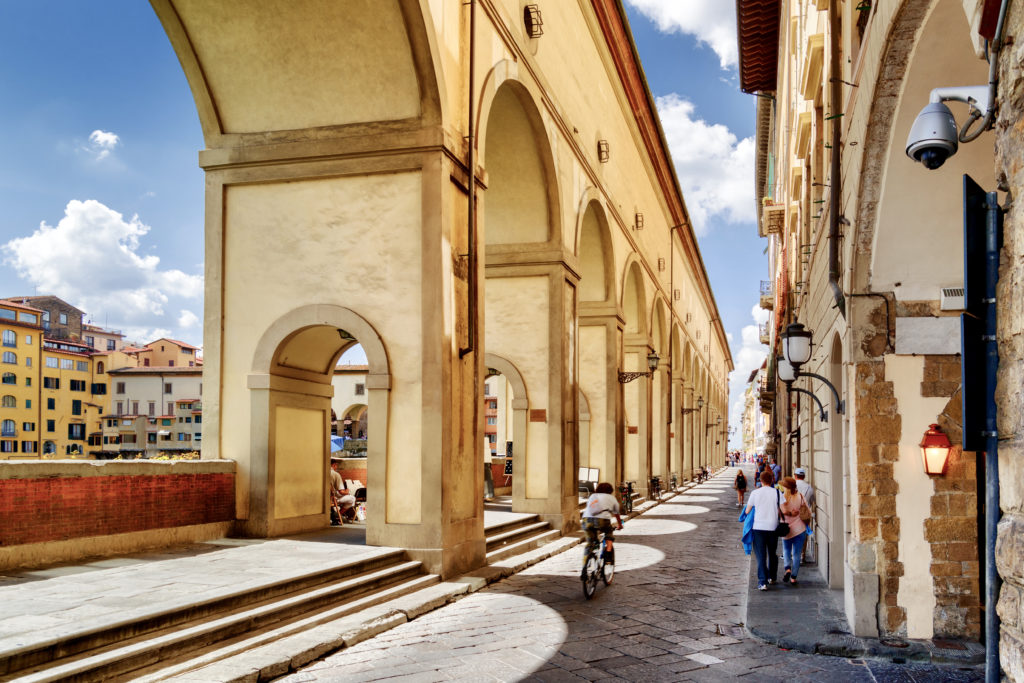
9. Vasari Corridor
The Vasari Corridor was built in 1564 by architect and art historian Giorgio Vasari. It’s a one kilometer elevated passageway above the Ponte Vecchio.
The corridor was commissioned by Cosimo de Medici (the first Grand Duke of Florence) for the marriage of his son, Francesco I, to Joan of Austria.
The Vasari Corridor connected the Palazzo Vecchio (government headquarters) to the Pitti Palace (the Medici’s official residence).
It served as a private walkway for the Medici and high ranking individuals. This way, they didn’t have to deal with the riff raff of Florence.
Inside the corridor, you’ll find the portrait collection of the Uffizi Gallery. There’s over 1000 paintings, including works by Filippo Lippi, Rembrandt, Velazquez, and Delacroix.
The Vasari Corridor is scheduled to open to the public via a special ticket in May 2024.
10. Palazzo Vecchio
The Palazzo Vecchio is an absolute must visit attraction in Florence. So much history has happened there!
The palazzo was Florence’s seat of power and the home of the City Council that governed the republic.
On the first floor of the palace, you can visit the Hall of the Five Hundred, awash with battle frescos by Giorgio Vasari. On the second floor are the sumptuously decorated private rooms of the Medici, with recently restored frescos in the beautiful Apartment of the Elements.
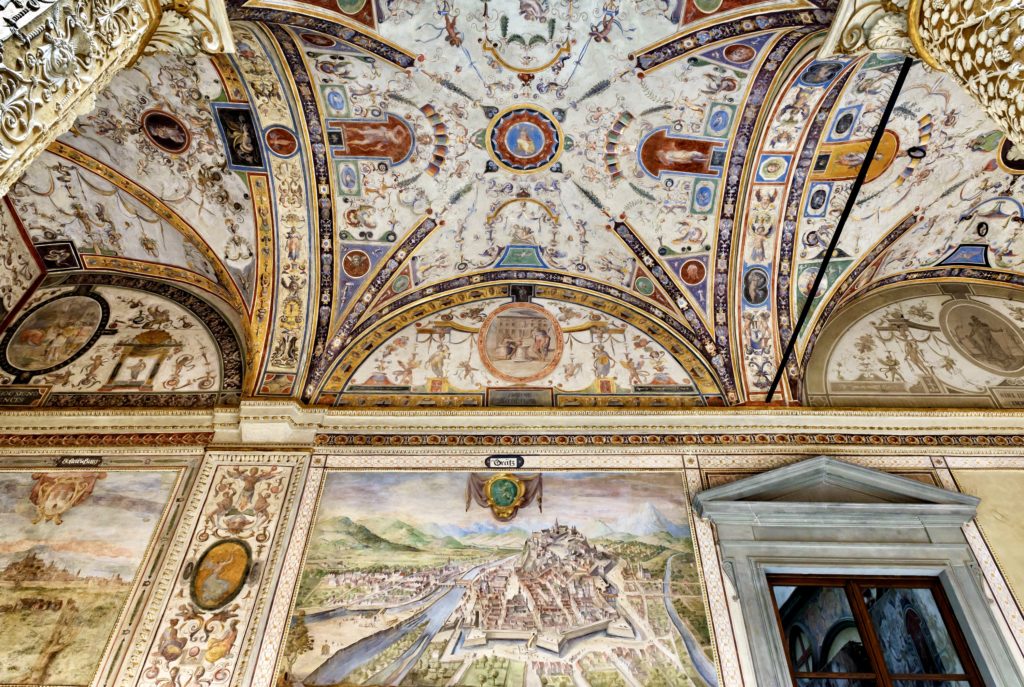
If you’re up for a climb of 400 steps, the Tower of Arnolfo offers 360 views. You enter via the Museum of Palazzo Vecchio, with a combined ticket for Palazzo Vecchio or for an additional small fee.
Click here to pre-book a skip the line ticket.
You can also book a guided tour of the palace. There is a guided secret passages tour with lunch. This guided 2 hour tour covers the palace and the Piazza della Signoria.
Another popular 2 hour guided tour includes the palace and a climb of the Tower of Arnolfo. You can also book a private guided tour.
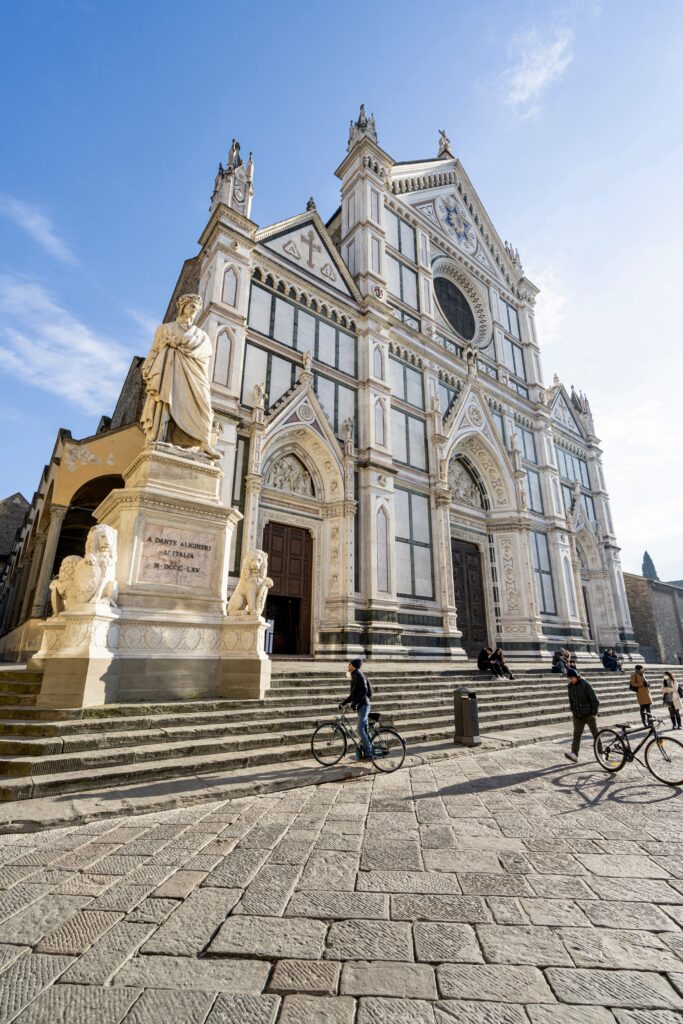
11. Basilica of Santa Croce
The Basilica of Santa Croce is a must visit attraction in Florence for lovers of Renaissance art. The basilica dates from 1280.
It boasts one of the greatest assemblages of frescos, painting, sculptures, and funeral tombs in the world. The highlight are the frescos by Giotto in the Bardi Chapel and the Peruzzi Chapel.
Santa Croce is also the resting place of storied Renaissance luminaries. You can find funeral tombs for Michelangelo, Ghiberti, Galileo, Dante, and Machiavelli.
Santa Croce also houses the famous Cimabue Crucifix. The artifact was damaged in a devastating flood in 1966, but has been somewhat restored.
You can book a skip the line ticket + tour of Santa Croce. Or go on a private tour of the fascinating complex.
12. Basilica of San Lorenzo Complex
While Santa Croce holds the superior art collection, the Basilica of San Lorenzo is more famous.
San Lorenzo was the official church of the Medici family. Michelangelo himself designed the simply stunning New Sacristy of the Medici Chapels between 1520-34.
The chapel’s coffered dome is similar to Rome’s Pantheon. The walls are clad with pink green, gold, and white marble.
There are two tombs decorated with allegories of the passage of time carved by Michelangelo — Dusk, Dawn, Day, Night. Night is regarded as one of Michelangelo’s finest works.
There’s also a secret room where it’s believed Michelangelo’s hid in 1531 during the Medici’s return to power. The room contains drawings and sketches believed to be by Michelangelo himself, hidden from public view for centuries.
In November 2023, the secret room opened to the public on a limited basis. Tickets are hard to come by though, and they’re already sold out through March 2023.
The other thing to see in San Lorenzo is the Chapel of the Princes.
This is the main mausoleum for the Medici Family. Cosimo de Medici commissioned it in 1568. But construction only began in 1602.
The chapel walls are clad with polychrome marble and precious stones. The cupola of the chapel features a fresco by Pietro Benvenuti. The sepulcher for Lorenzo the Magnificent is adorned with Michelangelo’s Madonna and Child sculpture.
>>> Click here to book a skip the line ticket to the Medici Chapels
13. Santa Maria Novella
Santa Maria Novella was founded in 1279 by a Dominican order. The basilica has a similar design to the Duomo and Santa Croce. Polychrome and white marble create a striking front facade.
The interior is a true marvel. It holds one of the most famous paintings in Italy, the Holy Trinity by Masaccio. Masaccio was an early Renaissance superhero, who tragically died young of malaria at only 27.
You’ll also want to visit both of the Strozzi Chapels. The Filippo Strozzi Chapel is to the right of the main altar. The other Strozzi Chapel is to the left up a flight of stairs.
The Filippo Chapel contains precious frescos by Filippino Lippi, an early Renaissance luminary. The frescos, dating from 1502, depict the life of the apostles Philip and James.
The choir contains another series of frescos by Domenico Ghirlandaio and his young apprentice Michelangelo.
Another highlight of Santa Maria Novella is the Chapter House, erected circa 1350, called the Spanish Chapel. It’s a bit of a hidden gem in Florence.
It’s a room completely covered with frescos by Andrea di Bonaiuto. The fresco cycle celebrates the spiritual and intellectual achievements of the Dominican order.
Click here to pre-book a ticket. You can also take a 2 hour guided tour of the basilica and its ancient pharmacy.
14. Orsanmichele | San Michele in Orto
Designed by Francesco Talenti and others, Orsanmichele is a well preserved and important 15th century Florentine church. It’s eccentric looking. Orsanmichele rises up like a three story brown rectangle.
But it’s a treasure trove of Renaissance sculpture — a sort of street view museum. Orsanmichele was originally Florence’s central grain market. It was converted into a church in 1380.
Inside, the church has a spectacular bejeweled Gothic Tabernacle altar, with a painting of the Madonna della Grazie. Legend holds that those who prayed before her were granted miracles. The original painting was lost and replaced with a 1497 painting by Bernardo Daddi.
Orsanmichele is most noted for its incredible sculpture, decorating the exuberant Gothic facade. The facade has 14 niches, each one housing a statue of a patron saint commissioned by Florence’s guilds.
By far, Orsanmichele’s most famous sculpture is Donatello’s St. Mark. It’s the first truly Renaissance piece of art (sculpture was more advanced than painting).
Orsanmichele is right in the center of Florence, just minutes from the Palazzo Vecchio. But it’s a bit of a hidden gem, where you can escape the crowds. Right now, the Orsanmichele Museum is only open on Monday and Saturday morning.
15. Pitti Palace
The magnificent Palazzo Pitti is one of Florence’s most stunning architecture gems. Built in 1457, it was designed by Brunelleschi and built for the Florentine banker Luca Pitti, a Medici rival.
But, like everything else it seems, the palace soon became Medici property. In 1549, Cosimo de’ Medici’s wife purchased the Pitti Palace.
The most important museum is certainly the Palatine Gallery. It occupies the left wing of the first floor.
The gallery houses an impressive collection of over 500 paintings, chock a block on top of each other amid lavish furnishings.
There are works by Raphael, Titian, Rubens, Caravaggio, and other European and Italian painters.
The Royal Apartments showcase styles from three different eras of ownership. You’ll find Baroque frescoed ceilings, gilded inlaid work, Rococo stucco, and red damask decorations.
The decor is definitely not to my taste, too over the top ostentatious. But amid the cacophony, there’s a beautiful Caravaggio painting, Knight of Malta.
If you want to know more, here’s my guide to visiting the Pitti Palace. Click here to book a skip the line ticket. You can also book a guided tour of the palace and the Boboli Gardens.
16. Strozzi Palace
The Strozzi were one of Florence’s wealthiest families. They were exiled from Florence in 1434. But, after accumulating more power, they made a triumphant return in 1466.
Once home, the Strozzi’s first mission was to build a mighty palazzo as a symbol of their strength. They wanted to eclipse the Pitti Palace.
The palace looks like a small rectangular fortress. It’s very symmetrical, with a stone facade that changes from rough hewn (on the bottom) to refined (at the top). The interior courtyard is impressive, surrounded by an arched stone arcade.
The palace remained in the hands of the Strozzi family until 1937. Now, it’s Florence’s largest space for contemporary art exhibitions. If you want to see well displayed art, this is your place. The Palazzo Strozzi holds three major exhibitions annually.
>>> Click here to book a Strozzi Palace exhibition ticket
17. Boboli Gardens
The historic Boboli Gardens is the backyard of the Pitti Palace. It’s the largest green space in Florence. The Boboli Gardens sprawls over 11 acres. The gardens are effectively an open air museum, with hundreds of nooks to explore.
They’re re laid out in the Italian style, with beautifully worn Renaissance statues and fountains. The famous Fountain dell’Oceano and the Bathing Venus were sculpted by the underrated Giambologna.
The Grotto Grande, also known as the Buontalenti Grotto’s, is a fascinating place. In 16th century Tuscany, it was the fashion to build decorative grottos reconstructing natural caves.
The grotto once had a fresco by Michelangelo (now in the Accademia) and has copies of his four slaves.
An interesting sculpture is the modern Cracked Face Statue, Tindaro Screpollato, by Igor Mitoraj.
The bronze face is huge, with green streaks running through the cracks that look like tears. The crumbling visage symbolizes both human fragility and strength.
Click here to pre-book an entrance ticket to the Boboli Gardens. Click here to book a 1 hour guided tour of the gardens.
18. Piazzale Michelangelo
Piazzale Michelangelo is one of Florence’s best viewpoints. You can see a postcard worthy view of the entire cityscape of Florence.
Like Piazza della Signoria, the square has a monumental copy of Michelangelo’s David, delivered by nine pairs of oxen in 1873.
Piazzale Michelangelo isn’t ancient. In fact, it’s a fairly recent addition, designed by Giuseppe Poggi. It was built in 1869 as part of the redevelopment of Florence.
In addition to the David, there are bronze copies of the four allegories from the Medici Chapel in San Lorenzo.
How do you get to the Piazza Michelangelo? Take bus #12 (from Boboli Gardens), bus #13 (from Ponte Niccolo), or the HopOn/Hop Off Bus. More effortlessly, you can just take a taxi. There’s also a parking lot, if you have a car.
If you want to make the hike from downtown Florence, wear comfortable shoes. You can start after crossing the Ponte Vecchio.
There’s a serpentine path from Piazza Poggi. Or you can follow the 2 kilometer Via Michelangelo from Piazzo Ferruccio.
You can also book an electric bike tour of Florence that includes sunset views from the piazza and eliminates the climb.
19. San Miniato al Monte Church
When you’re done at the Piazzale Michelangelo, you should walk 5 minutes and visit the spectacular and well preserved Church of San Miniato al Monte. It’s Florence’s crowning glory.
The church is perched even higher and with a better view. Building began in 1018. Like the Baptistry, the church is over 1000 years old.
San Miniato has Florence’s emblematic white and green marble facade. It’s a harmonious piece of Tuscan Romanesque architecture, a very unique building in Florence.
When you walk through the turquoise doors, you’re greeted by a spectacular interior.
Every inch of the church is covered in mosaics, gold leaf, or geometric patterns, with a spectacular mosaic decorating the half dome in the apse. The marble floor is decorated with zodiac signs.
The monks of San Miniato still sing Gregorian chants at Vespers, in a small chapel at the back of the church. Anyone can go and listen. They usually chant at 5:30 pm in the summer and 4:30 pm in the winter.
Click here to book a 2 hour guided tour of the ancient basilica.
20. Museum of the San Marco Monastery
San Marco Monastery is a must visit attraction in Florence if you love the early Renaissance. In 1437, Cosimo de Medici decided to rebuild a crumbling convent complex.
He hired the architect Michelozzo. The walls were decorated by Fra Angelico and his workshop.
Fra Angelico’s humanistic pieces, with delicate palettes, led him to be dubbed the “Angelic Painter” or Il Beato (the Blessed). Giorgio Vasari described Fra Angelico as a “rare and perfect talent.”
The highlight of the San Marco Museum is the Sala dell’ Ospizio, where the most important Fra Angelico paintings are housed, including The Last Judgment, The Crucifixtion and Saints, and The Annunciation (at the top of the stairs).
There are also seminal works by Ghirlandaio, Michelangelo’s teacher, including a Last Supper fresco in the Refectory. Legend holds that the cherries arranged on the tablecloth spell out a rhyme.
You can also visit the plain room where the fanatical monk Savonarola, the scourge of the Medici, lived and worked.
Also stop in to peer at the simple cell where Cosimo de Medici came to meditate. It’s decorated with Fra Angelico’s Adoration of the Magi.
Click here for a skip the line ticket. Click here for a fascinating tour that gives you insight into Fra Angelico, Savonarola, and the Medici.
21. Brancacci Chapel in Santa Maria del Carmine
The Brancacci Chapel is another supreme example of early Renaissance painting. It’s completely filled with frescos by Masaccio and his workshop.
It’s considered one of the three important chapels of the Renaissance, along with the Giotto’s Scrovegni Chapel in Padua an Michelangelo’s Sistine Chapel in Rome.
As I mentioned earlier, Masaccio was an influential painter, despite dying mysteriously at just 27. He was one of the first painters in art history to experiment with single point perspective and three dimensional space.
Felice Brancacci, commissioned the fresco cycle in 1424. They were depict the life of St. Peter, from original sin to the salvation of man. After Masaccio’s death, the frescos were completed by Fillipino Lippi.
In the upper registry, there’s one of Masaccio’s greatest masterpieces, The Tribute Money. It’s a story from the new Testament when Christ is confronted by a tax collector. Christ performs a miracle, causing money to appear in the mouth of a fish.
Just to the left of The Tribute Money is another Masaccio must see masterpiece, the Expulsion of Adam and Eve From Eden.
An armed angel banishes the pariahs. Adam appears ashamed and Eve cries. It’s an emotional painting.
Click here to pre-book a ticket.
22. Basilica of Santo Spirito
This is Brunelleschi’s second church in Florence. It’s a hidden gem in Florence, sitting in a shabby chic piazza in the Oltrarno district. If you’re hungry, stop in at Gustapanino for a panini.
Built in 1440, the church is a pivotal work of the early Renaissance. Brunelleschi was one of the first architects to use perspective and geometry, breaking away from outdated medieval church styles.
Brunelleschi thought beauty resided in harmony and mathematical perfection. He was inspired by the classicism of ancient Rome, creating an unassuming exterior and a rather severe interior. Brunelleschi used a latin cross (like a small t) floorpan.
The main altar, an out of place Baroque affair, is at the center of the crossing square. Three sides of Santo Spirito have a continuous succession of 40 identical semi-circular chapels. The massive pietra forte Corinthian columns give the church a monumentality.
Santo Spirito houses a wooden crucifix attributed to Michelangelo. It was carved when he was only 17. Restored, it now hangs 22 meters high in the sacristy.
There are also some notable frescos in the Bini-Capponi Chapel. And art lovers will should inspect Domenico di Zanobi’s Maddona of the Relief in the Velutti Chapel.
23. Michelangelo’s Laurentian Library
Commissioned by Pope Clement VII, the Laurentian Library is a revolutionary and blissfully uncrowded museum in Florence. Construction began in 1524 and the library opened in 1571.
The Laurentian Library consists of a reading room and a 48 foot vestibule built atop the San Lorenzo cloisters. It has one of the world’s most important collections of manuscripts, which belonged to the Medici family.
In designing the library, Michelangelo broke away from classical tradition and rules of proportion. He designed a dream-like space with curves and unusual configurations.
The seemingly oversize Triple Staircase conveys a sense of movement. It seems to pour forward like pools of liquid. It may be the first freestanding staircase in architectural history.
he staircase of the Laurentian Library is surrounded by striking structures that nearly eclipse the walls themselves. These walls are adorned with bold architectural features, including exceptionally large brackets that hang low, adding drama to the design.
In a unique twist, some architectural elements are nestled into niches, transforming the architecture into a form of art. Columns are either embedded into the walls or seem to balance on the corbels, creating a captivating visual effect.
Contrasting with the dynamic vestibule, the Reading Room unfolds in a more horizontal layout. It features two rows of wooden benches, known as plutei. The room is characterized by a striking terra cotta floor in red and white, and a beautifully designed coffered ceiling.
Michelangelo’s dramatic and inventive architectural style marked the beginning of Mannerism, a late Renaissance period that reinvented and put a stylized twist on classicism.
24. Chapel of the Magi | Capella dei Magi
The beautiful Chapel of the Magi is located in the Medici-Riccardi Palace. The palace itself is rather a brooding rusticated stone affair.
But upstairs in the Piano Nobile is one of the most beautiful chapels in Italy — the Chapel of the Magi.
The Chapel of the Magi was a private chapel used exclusively for the Medici’s prayer and devotion. The chapel is decorated with a beautiful series of frescos painted in 1459 by Benozzo Gozzoli.
The frescos are in two parts, the Procession of the Magi on three walls in the main room and the Adoration of the Magi in the chancel. They’ve recently been restored to their full technicolor glory.
The frescos are meant to glorify the Medici family. It was a form of propaganda to show their wealth and greatness. Throughout the chapel, there’s an abundance of purple porphyry and gold, just to underscore the point.
On the east wall, there’s a portrait of Lorenzo the Magnificent at the age of 10 on a white horse. There’s also a portrait of Giuliano, Lorenzo’s brother who was assassinated in the Pazzi Conspiracy.
Cosimo the Elder appears riding a donkey, a reference to Jesus himself. Is Cosimo trying to appear modest or as the second coming? It’s delightfully unclear.
25. Casa Buonarotti
Casa Buonarroti is fantastic. It’s one of the most underrated and overlooked museums in Florence.
The museum was a property once owned by the famed Renaissance artist Michelangelo, whose last name was Buonarroti. Later, the palace was transformed into a house-museum by his heirs.
The museum was designed to celebrate the great artist’s legacy. It’s a visual, and somewhat romanticized, biography of his life. If you’re a Michelangelo fan, Casa Buonarroti is a must visit attraction in Florence.
Casa Buonarroti has two of Michelangelo’s earliest known works of sculpture. It houses Michelangelo’s majestic wooden model for the facade of the Basilica of San Lorenzo.
To top that, this tiny museum has the world’s second most important collection of Michelangelo drawings.
26. Church of the Annunciation | Santissima Annunziata
Santissima Annunziata was rebuilt in 1444-81 by the famed Florentine architect Michelozzo. It’s considered his masterpiece. The church also houses some superb works of Florentine art.
After you enter, on the left, you’ll see an elegant marble temple by Michelozzo. The temple was commissioned to hold the miraculous picture of the Annunciation.
You’ll find beautiful Andrea del Castagno’s frescos, Redeemer and St. Julian and Trinity. Another chapel has a panel by Perugino, Ascension of Christ.
The sculptor Giambologna’s tomb is inside, adorned with frescoes, statues, and reliefs. And there’s a beautiful painting by Giorgio Vasari, Saint Luke Painting the Virgin.
In the cloister are the chapterhouse, several chapels, and the sacristy. The Votive Chapel boasts frescos by Andrea del Sarto, Cosimo Rosselli, Alesso Baldovinetti.
27. Bardini Gardens
The Bardini Villa and Gardens are situated between Costa San Giorgio and Borgo San Niccolo. They’re close to the more famous Boboli Gardens of the Pitti Palace, but much less crowded.
Beginning in the 13th century, the gardens belonged to the Mozzi family. In the 20th century, famous art dealer Stefano Bardini purchased the villa, gardens, and the surrounding properties. The gardens officially opened to the public in 2005, after a massive restoration.
The Bardini Gardens contains 10 acres of woods, cypress trees, terrace gardens, and fruit orchards. It’s the perfect serene environment to take a relaxing stroll or stop to read a book.
The most famous spot is the whimsical Wisteria Tunnel of purple flowers. If you go to the gardens in mid-April/May, the wisteria will be in peak bloom.
The best spot for views is from the Belvedere terrace, where you get a panoramic views of the Duomo, Santa Croce, and the nearby town of Fiesole.
I hope you’ve enjoyed my guide to the top attractions in Florence. You may enjoy these other Florence travel guides:
- 1 Day itinerary for Florence
- 2 Day Itinerary for Florence
- 3 Day Itinerary for Florence
- Ultimate Guide to Florence’s Museums
- Guide To Florence’s Best Churches
- Florence Art Bucket List
- Hidden Gems in Florence
- Best Views in Florence
- Best Day trips From Florence
- Free Things To Do in Florence
- Guide to the Piazza della Signoria
Pin it for later.

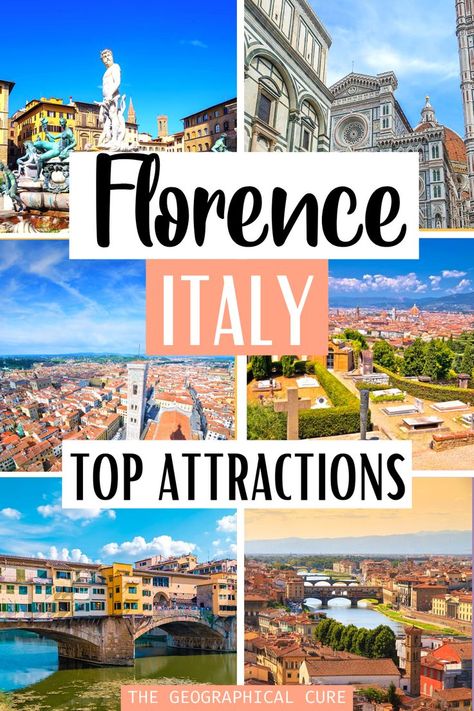
So beautiful and so much to see; I reckon trying to take in all these sights would require more than one trip. Florence is on our bucket list.
Yes there’s so much to do and see in Florence. I’m going again in May for 3 days. But it doesn’t seem enough!
What a great article. The only “deficit” is that all 27 attractions are must-sees. Think about what interests you and choose accordingly. Don’t try to see everything. There are other worthy attractions which are not on this list. Opera? Natural History Museum? Or just chilling in a bar or caffè. We went to the Basilica of San Lorenzo complex to gain access to Michelangelo’s Library, but the library was not open. So be prepared to be flexible and modify your itinerary on the fly.
Thank you so much for your well-written and beautifully-photographed article describing what to see in Florence. Brava ragazza 😀